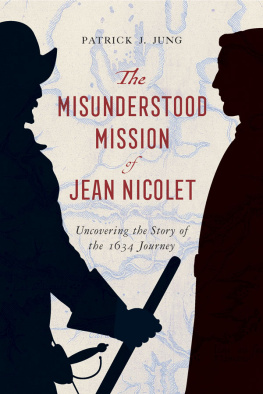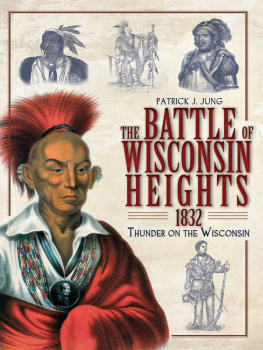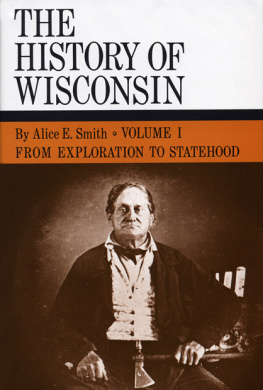The Misunderstood Mission of Jean Nicolet

Published by the Wisconsin Historical Society Press
Publishers since 1855
The Wisconsin Historical Society helps people connect to the past by collecting, preserving, and sharing stories. Founded in 1846, the Society is one of the nations finest historical institutions.
Join the Wisconsin Historical Society: wisconsinhistory.org/membership
2018 by the State Historical Society of Wisconsin
E-book edition 2018
For permission to reuse material from The Misunderstood Mission of Jean Nicolet (ISBN 978-0-87020-879-9; e-book ISBN 978-0-87020-880-5), please access www.copyright.com or contact the Copyright Clearance Center, Inc. (CCC), 222 Rosewood Drive, Danvers, MA 01923, 978-750-8400. CCC is a not-for-profit organization that provides licenses and registration for a variety of users.
Photographs identified with WHI or WHS are from the Societys collections; address requests to reproduce these photos to the Visual Materials Archivist at the Wisconsin Historical Society, 816 State Street, Madison, WI 53706.
The silhouettes on the front cover are based on statues of Samuel de Champlain and Jean Nicolet located in Plattsburg, New York, and Red Banks, Wisconsin, respectively. On the front flap is The Landfall of Jean Nicolet, WHI Image ID 1870.
Cover design by TG Design
Typesetting by Integrated Composition Systems
22 21 20 19 18 1 2 3 4 5
Library of Congress Cataloging-in-Publication Data
Names: Jung, Patrick J., 1963 author.
Title: The misunderstood mission of Jean Nicolet : uncovering the story of the 1634 journey / Patrick J. Jung.
Description: Madison WI : Wisconsin Historical Society Press, [2018] | Includes bibliographical references and index. |
Identifiers: LCCN 2018011945 (print) | LCCN 2018013590 (e-book) | ISBN 9780870208805 (e-book) | ISBN 9780870208799 (hardcover : alk. paper)
Subjects: LCSH: Nicollet, Jean, 15981642. | CanadaHistoryTo 1763 (New France) | Champlain, Samuel de, 15741635 | WisconsinDiscovery and exploration. | ExplorersFranceBiography.
Classification: LCC F1030.15 (e-book) | LCC F1030.15.J86 2018 (print) | DDC 910.92dc23
LC record available at https://lccn.loc.gov/2018011945">https://lccn.loc.gov/2018011945
For Nancy Oestreich Lurie, whose excellence as a scholar made this story possible.
C ontents

New France in the age of Champlain and Nicolet. MAP BY RICK REGAZZI
T he story of Jean Nicolet figures heavily into the early history of Wisconsin. For many years, Wisconsin schoolchildren learned the story of how, in 1634, Nicolet arrived at Green Bay believing he had discovered the Northwest Passage, the elusive waterway through North America that would provide Europeans with a route to Asia and the riches of the Kingdom of Cathay, or China. According to this oft-told chronicle, Nicolet was one in a long line of explorers who, since the time of Christopher Columbus, had risked life and limb in pursuit of this sublime dream. After traveling hundreds of miles by canoe across Lakes Huron and Michigan, Nicolet donned a richly embroidered Chinese robe for the occasion of his arrival, but, of course, he did not meet the powerful mandarins who represented the Ming emperor. He met American Indians, particularly the Puans (also known as the Winnebagos), one of the groups that constituted Wisconsins aboriginal inhabitants, and Natives who, in Nicolets eyes, probably did not seem very different from those with whom he lived on the eastern shores of Lake Huron. Nicolet demonstrated the might of his pistols. The Indians who assembled by the thousands honored him with great feasts of roasted beaver. He was disappointed, perhaps even crestfallen, when he realized that he had not reached the fabled wealth of the Far East.
This narrative is almost always accompanied by visual images paintings in particularthat depict Nicolet as appearing a bit foolish for believing he had made landfall in China when, in fact, he was only in present-day Wisconsin. I had seen these images and read this story in the social studies book I possessed as a child when, during the 19731974 school year, I attended the fourth grade at 81st Street School in Milwaukee. Later I learnedas an academic historian passing from young adulthood into middle age and after many years of research into the history of Indianwhite relations in the Great Lakes regionthat much of this story, from beginning to end, is patently false. I also learned the true story is richer, more interesting, and more complicated than that which historians have presented over the past one hundred fifty years.
Nicolet told the story of his journey several times before his death in 1642 and perceived it to be one of the highlights of his career in the colony of New France, which in Nicolets time consisted of little more than the small settlement at Quebec and a trade network and missionary stations that stretched northward into the Canadian Shield and westward into Lake Huron. The Jesuit missionaries to whom he related the account of his expedition documented its principal events. However, in the annual publications known as the Relations that recounted their activities in North America, the Jesuit missionaries did not provide as much detail concerning Nicolets journey as the modern researcher would desire. These vague, often ambiguous texts have been the principal culprits that have allowed earlier Nicolet scholars to insert any number of factual errors, poorly supported conclusions, and even outright fabrications into their analyses. Nevertheless, the historical record contains enough information to discern the purpose of Nicolets mission and the context in which it occurred. In addition, the itinerary, route, and significant events of the journey can be determined through a meticulous reading of the extant sources. Reconstructing the particulars of Nicolets mission is largely an academic exercise but one that scholars have generally botched over the past century and a half.
As I conducted my research, I discovered earlier historians as well as scholars up to the present day have consistently described Nicolet primarily as an explorer; this is incorrect. His expedition to Green Bay was, in one sense, a voyage of discovery, as he was the first Frenchman to visit the region. Yet, it was the only such voyage Nicolet undertook. In his career prior to and after his 1634 voyage, he had served in other capacities. After arriving in New France in 1619, Nicolet worked as an interpreter between the various tribes and the French trading companies with which the Indians exchanged peltries for goods of European manufacture. He also traded with the Indians on his own account and later assisted the Jesuit missionaries as a lay evangelist. Of great importance was his role as a diplomat to the Indian nations per the orders of Samuel de Champlain, the commander of the colony, and Champlains successor, Charles Huault de Montmagny. Nicolet had participated in no journeys of exploration before 1634. The same was true of his career after his 1634 voyage and up to his death, a period during which he served as an interpreter at Trois-Rivires in Quebec.
Most significantly, his voyage to Green Bay was a diplomatic mission, not a voyage of discovery. I learned, contrary to established belief, Nicolet was not seeking a water route to China, nor was his principal duty the acquisition of geographical information about the Great Lakes. His primary missionin fact, his only objectivewas to negotiate peace between New Frances Indian allies and the Puans at Green Bay. Any other duties he performed were subordinated to this overarching task. Thus, Nicolet was not really a great explorer; he was, on the other hand, a great diplomat to the Indians during his years of service in New France.













